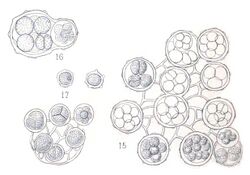Biology:Hariotina
| Hariotina | |
|---|---|

| |
| Hariotina reticulata | |
| Scientific classification | |
| (unranked): | Viridiplantae |
| Division: | Chlorophyta |
| Class: | Chlorophyceae |
| Order: | Sphaeropleales |
| Family: | Scenedesmaceae |
| Genus: | Hariotina P.-A.Dangeard |
| Species | |
| |
Hariotina is a genus of green algae in the family Scenedesmaceae.[1] They are classified in the subfamily Coelastroideae.[2]
The genus name of Hariotina is in honour of Paul Auguste Joseph Valentin Hariot (1854-1917), who was a French naturalist, botanist (Bryology, and Algology) and apothecary. In 1882, he worked in the Cryptogam department of the National Museum of Natural History, France in Paris.[3]
The genus was circumscribed by Pierre Augustin Dangeard in Botaniste vol.1 on page 162 in 1889.
Species of Hariotina are typically found in stagnant water in tropical or subtropical regions. Some species have also been found in temperate regions and large rivers.[2]
Description
Hariotina consists of free-living colonies (called coenobia) of four, eight, 16, 32, or (rarely) 64 cells organized into a hollow sphere. Cells are roughly spherical and connected at the top via long stretches of the outer layer of the cell wall. Cells contain a single chloroplast, each with one pyrenoid.[4]
Hariotina is morphologically similar to the genus Coelastrum, and species of Hariotina were once considered to be part of Coelastrum. Whereas Coelastrum has cells that are joined to each other at their bases, Hariotina has cells connected to each other at their apices. In addition, colonies of Hariotina have a surrounding layer of mucilage, which is absent in Coelastrum.[5]
Species of Hariotina differ subtly from each other in terms of the size and shape of colonies, as well as the intercellular strands that connect cells. However, a combination of molecular markers (18S rDNA, ITS, and tufA) appears to be the most reliable way to identify species.[2]
References
- ↑ See the NCBI webpage on Hariotina. Data extracted from the "NCBI taxonomy resources". National Center for Biotechnology Information. http://ftp.ncbi.nih.gov/pub/taxonomy/. Retrieved 2007-03-19.
- ↑ 2.0 2.1 2.2 Wang, Qinghua; Liu, Xudong; Li, Shuyin; Xiong, Qian; Hu, Zhengyu; Liu, Guoxiang (2020). "Cryptic species inside the genus Hariotina (Scenedesmaceae, Sphaeropleales), with descriptions of four new species in this genus". European Journal of Phycology 55 (4): 373–383. doi:10.1080/09670262.2020.1737968. Bibcode: 2020EJPhy..55..373W. https://figshare.com/articles/dataset/Cryptic_species_inside_the_genus_i_Hariotina_i_Scenedesmaceae_Sphaeropleales_with_descriptions_of_four_new_species_in_this_genus/12320096.
- ↑ Burkhardt, Lotte (2022) (in German) (pdf). Eine Enzyklopädie zu eponymischen Pflanzennamen. Berlin: Botanic Garden and Botanical Museum, Freie Universität Berlin. doi:10.3372/epolist2022. ISBN 978-3-946292-41-8. https://doi.org/10.3372/epolist2022. Retrieved January 27, 2022.
- ↑ Bicudo, Carlos E. M.; Menezes, Mariângela (2006). Gêneros de Algas de Águas Continentais do Brasil: chave para identificação e descrições (2 ed.). RiMa Editora. pp. 508. ISBN 857656064X.
- ↑ Hegewald, Eberhard; Wolf, Matthias; Keller, Alexander; Friedl, Thomas; Krienitz, Lothar (2010). "ITS2 sequence-structure phylogeny in the Scenedesmaceae with special reference to Coelastrum (Chlorophyta, Chlorophyceae), including the new genera Comasiella and Pectinodesmus". Phycologia 49 (4): 325–335. doi:10.2216/09-61.1. Bibcode: 2010Phyco..49..325H.
Wikidata ☰ Q5657664 entry
 |

